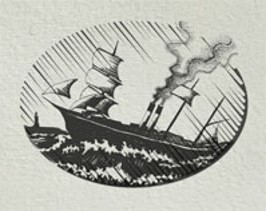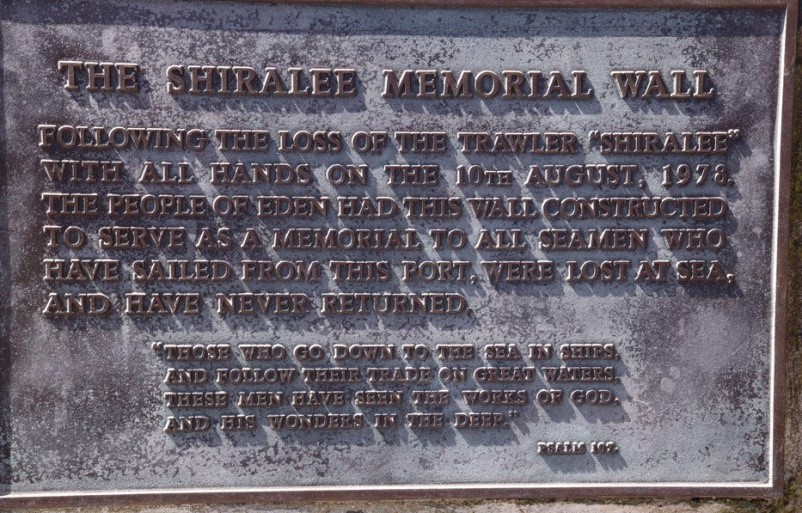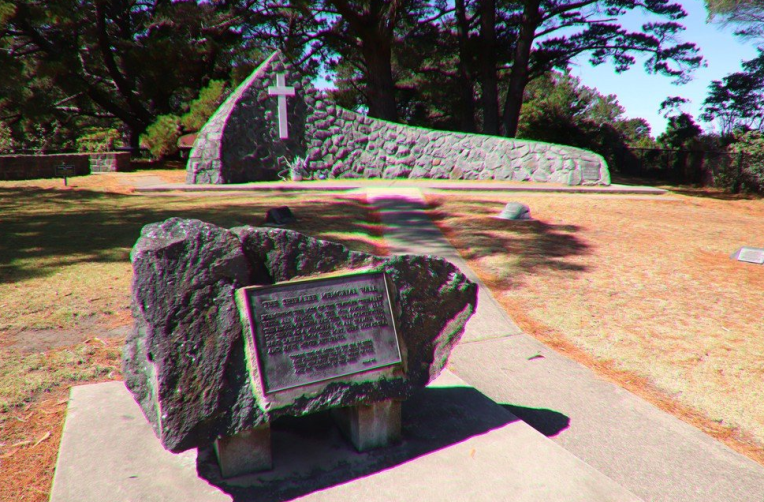Ships and Shipwrecks
SS Ly-ee-Moon
Many vessels have been driven ashore and lost in or near Twofold Bay and Green Cape but the most famous was probably the “Ly-ee-moon” (Flying Fish) which began life in 1859 as a sister ship to the Royal Yacht “Victoria and Albert” but by 1886 (after many refits) was plying passengers between Melbourne and Sydney. The steamer was ultimately wrecked on the night of 30 May 1886 while rounding Green Cape at a speed of 11.5 knots in a strong on-shore wind she drifted from her due North course.
At 8.30pm on the fatal night, Captain Arthur Webber left the Third Officer, James Fotheringhame, on watch with instructions to call Webber when the ship was to pass the Green Cape Lighthouse, or at least no later than 9.45pm. Fotheringhame later claimed that he called Webber at 9.10 pm. Captain Webber however claimed he was called at 9.28 pm, just two minutes before the ship was wrecked; the ship was steaming directly for the rocks at the foot of the lighthouse. The vessel crashed to a halt as he put the engines into reverse, but became stuck fast. Any hope failed when the hull broke completely in two after ten minutes. The stern remained on the outer reef, but the bow section containing the saloon broke away and drifted towards the shore.
Despite heroic rescue attempts, only 5 of the 45 passengers and 10 of the 41 crew survived, and only 24 bodies were subsequently recovered from the sea. Among the bodies was that of Mrs Flora McKillop, the mother of Mary McKillop, Australia’s first saint and founder of the Order of St. Joseph. Sister Mary established the Convent of St. Joseph here in 1888 as a means of showing her appreciation for the rescue attempts, recovery of her mother’s body and subsequent kindness displayed by the residents of Eden in her distress. Those bodies that could be recovered, except that of Flora McKillop, were buried just north of the Green Cape Lighthouse (about 100 metres into the scrub off the access road), as they could not wait for transportation to Sydney.
An Inquest was held on 1 and 2 June 1886 at Eden before the Coroner, Mr Magnus, JP, of Eden. The jury delivered its verdict at 8.30 pm on 2 June 1886. It said in part that “gross neglect has been shown, but there has not been sufficient evidence before us to point to the guilty person or persons”.
Immediately after the inquest Fotheringhame was charged with manslaughter and then in Sydney was joined in the dock by Webber facing the same charge, but both men walked free. At the later Marine Enquiry, Captain Webber was charged with gross negligence, but Third Officer Fotheringham who was in charge when the steamer struck, was not charged. Captain Webber appeared before a judge and jury but the jury could not reach agreement and he was remanded to appear again, but never did because the Crown elected not to proceed any further.

More detailed information on the Ly-ee-Moon:
http://www.michaelmcfadyenscuba.info/viewpage.php?page_id=90
https://www.sea.museum/discover/library/research-guides/dunbar-shipwreck
Image of the Ly-ee-Moon from the Australian National Maritime Museum
Seamens Memorial
This memorial is located in Rotary Park near Lookout Point at the end of Imlay Street, Eden.
It was erected by the people of Eden following the loss of the trawler ‘Shiralee’ with all hands on 10th August, 1978, as a memorial to all seamen who have sailed from the Port of Eden and have been lost to the sea with their bodies never recovered.
The names of 24 unfortunate souls are displayed on plaques on the wall and within the nearby circular garden. Two of the plaques tragically bear two names, both fathers and sons, who were lost to the sea on separate occasions.
The earliest name commemorated is that of Peter Lia a Norwegian lad of 22, the only whaler to have ever been killed during the 100 year history of shore-based whaling from Twofold Bay.
On the night of 28th September, 1881 two of the Davidson whaling boats had harpooned a large Right Whale and were being towed by it when it suddenly turned, came up beneath one of the boats and smashed it in halves with its tail flukes. Peter Lia was the unfortunate oarsman directly beneath the path of the tail. All other crew members were rescued by the surviving boat and the search for Peter then proved fruitless and his body was never recovered.


The Bermondsey
In 1846 Benjamin Boyd, with others, became interested in a movement which had for its objective the introduction of a particular class of migrants to the colony of New South Wales. The association was known as the Colonization Society. Meetings were held throughout the English counties, where exhortations to join the different parties which were being formed for migration to New South Wales formed the principal theme of the various speakers. Recruits were found; advertisements appeared in the Home newspapers calling for persons desirous of migrating to the colony, and suggesting that opportunities be provided for disembarkation at ports other than Port Phillip and Port Jackson.
1848 an announcement was made concerning the first immigrant ship destined to land her people in Twofold Bay. A notice in the “Government Gazette” of November 15, 1848, from the Colonial Secretary’s Office, set out that the ship ”Bermondsey” was to have sailed from Plymouth about the 31st of August, with emigrants, direct for Twofold Bay, and settlers of Monaro district were invited to make arrangements for hiring them at that place and for removing them to their stations. The same day Sydney newspapers announced that another vessel, the “Simon Taylor,” was also to sail from Plymouth direct to Twofold Bay with emigrants.
Due to Boyd’s bankruptcy activities at Boydtown had ceased prior to the arrival of the “Bermondsey,” the buildings and shipping conveniences being under lease to a Sydney firm of commission agents, with local representatives in residence. Arrangements had been made with this firm for the victualling of the emigrants who were arriving on the “Bermondsey” during the period from disembarkation and securing positions the people were housed in the buildings at Boydtown.
The “Bermondsey” arrived at Twofold Bay on the 7th of December, 1848. The “Bermondsey’s” complement consisted of 184 persons, including children. Of this company 111 labourers, with their families, found employment within the districts of Monaro and Twofold Bay, the remainder seeking employment in Sydney and Port Phillip. Passage money amounted to £11/19/6 per adult. The “Simon Taylor” was struck off the sailing list for Twofold Bay.
Thus, though Benjamin Boyd had promulgated the scheme for the introduction of migrants through the port of Twofold Bay and failed to see the scheme realised, yet the buildings which he had caused to be erected and collectively named after him, actually housed the first shipload disembarked at a port in Australia other than Port Jackson or Port Philip.
Source: ‘Benjamin Boyd in Australia (1842-1849) : shipping magnate, merchant, banker, pastoralist and station owner, member of the Legislative Council, town planner, whaler’ by Wellings, H. P
We are looking for descendants of Bermondsey immigrants
The Bermondsey was the only immigrant ship that left England for the particular destination of Twofold Bay in 1848. The Eden Community Access Centre is interested in tracing the descendants of the Bermondsey with a view to documenting the impact the immigrants and their descendants have had on our local area.
Are you a descendant of Bermondsey Immigrants? These are some of the known surnames of passengers : Alexander, Armour, Berry, Blades, Bransley, Bridges, Buck, Burgess, Cameron, Carlyle, Chalmers, Cheeseman, Coates, Cockran, Corkhill, Cox, Crawford, Crooks, Currie, Davies, Dighton, Dennett, Duff, Dunn, Eglinton, Etsey, Forbes, Forrest, Frame, Guthrie, Haley, Hall, Hamilton, Hannah, Harrison, Hart, Hayes, Heaven, Hendry, Hewitt, Holmes, Howett, Hudson , Inglis, Jackson, Johnson, Kelly, Knowles, Lane, Laytham, Lodge/Ledge, Lucas, Ludford, McDougal, McEwan, McIntyre, McMann, McPherson, McVean, Miller, Moffitt, Neasmith, Neilson, Newlyn, O’Halloran, Parnell, Rae, Rankin, Rennie, Rogers, Samuels, Sharp, Shelton, Smillie, Spence, Steel, Stewart, Struthers, Summers, Summons, Tame, Thallon, Thompson, Thorn, Tivey, Ward, Webster, Wilson, Wood.
Some other associated surnames we have identified are: Cousemacker, Worland, Cridge, Goldby, Blacka, Gillespie, Wintle, Whiffen, Tyrrell, Green, Whyman, Turk, Hyland, Schuback, Easdown, Motbey, Turnbull, Douch, Witts.
If you or someone you know could be descendant from any of the above please contact us at the Eden Community Access Centre.